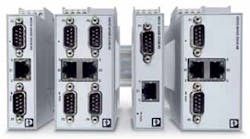Phoenix Contact's GW EIP/Modbus... gateway is available with one, two or four serial and one or two RJ45 Ethernet ports to map all types of Modbus protocols to an Ethernet/IP network.
One of the most persistent obstacles in industrial networking has been the chasm between two of the most widespread protocols, Modbus and EtherNet/IP. Their longtime inability to talk to each other caused huge inefficiencies, which forced users to jury rig hardware and program software to translate their data, or worse, try to extract their information manually.Thankfully, network gateways have evolved to ease some of these networking hurdles, and aid communications between standalone machines and control systems. For instance, Phoenix Contact launched its gateways in 2017 to better connect devices running ASCII, Profinet, Modbus or EtherNet/IP devices, and has steadily expanded the family to include new protocols.
Its latest gateway, EtherNet/IP to Modbus TCP/RTU (GW EIP/Modbus...), is available with one, two or four serial ports and one or two RJ45 Ethernet ports. It provides a simple path for migrating legacy serial devices to Ethernet using an intuitive, web-based configuration for mapping data from Modbus to EtherNet/IP. It supports all Modbus types, including TCP/IP, RTU and ASCII. For example, integrating RSLogix software is easy thanks to the gateway's write-to-tag feature that lets users quickly setup data transfers to the programming environment.
"As more users and industries move to Industry 4.0 and the Industrial Internet of Things (IIoT), we're seeing a huge push to get all the disparate protocols talking to each other," says William Dietz, associate product manager for communication interfaces, I/O and Networking business unit, Americas, Phoenix Contact. "But, just because IIoT and Industry 4.0 are coming, it doesn't mean users can take out all their existing equipment and infrastructure. This is why gateways like GW EIP/Modbus... are so important—they can greatly extend the life of those existing device by allowing them to speak one language."
GW EIP/Modbus... has a wide -40-70 °C temperature range and hazardous-location approvals, including Class I, Div. 2, Groups A, B, C and D, making it suitable for any industry. It also has a wide input voltage range of 10.8 VDC to 30 VDC.
"It's often difficult to adapt legacy devices to Ethernet and bring them into IIoT. GW EIP/Modbus is the solution," adds Jason Haldeman, senior product marketing specialist, I/O networks, Phoenix Contact. "The main goal of our development was to make GW EIP/Modbus easy to use by employing an intuitive, web-based interface that guides users through configuration, and limit the need for complex programming when interfacing with Rockwell Automation PLCs. This gives users options when deciding how the data is transferred to the PLC—either using an electronic data sheet (EDS) file or the write-to-tag function, which lets data be written directly to controller tags already declared in the user’s application program.
"Internal memory in GW EIP/Modbus... can also be used to gather and format data from master and slave devices, allowing messages to be structured to further reduce programming. This feature can also be used in conjunction with the EDS files to access this shared memory. All of these features enable users to quickly adapt the gateway to their machines and equipment."
To ensure secure configuration, GW EIP/Modbus... can be configured so only authorized client applications can connect using secure shell and secure sockets layer (SSH/SSL).
"In this cybersecurity age, we had to make sure GW EIP/Modbus had authentication certificates/software keys to prevent access by unauthorized users," explains Dietz. "Usually, a Certificate Authority administrator creates these certificates. This is also about including IT features for the OT devices, so IT can approve industrial devices on the network."
Dietz adds that diagnostics in GW EIP/Modbus... will get users get up and running fast. "There's all kinds of data in attached devices that can be listed in a web manager, such as EtherNet/IP session counts and numbers of packets going through a Modbus device," he says. "If users have this data, it can make diagnostics and troubleshooting a lot easier, which they'll appreciate, too."
Click here for more information.




